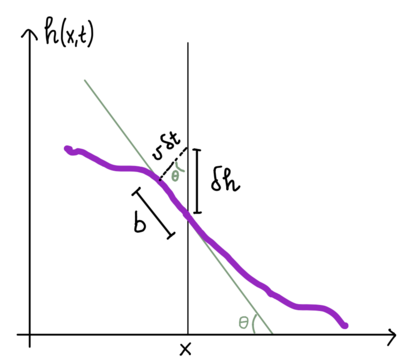L-2
Goal: The physical properties of many materials are controlled by the interfaces embedded in it. This is the case of the dislocations in a crystal, the domain walls in a ferromagnet or the vortices in a supercoductors. In the next lecture we will discuss how impurities affect the behviour of these interfaces. Today we focus on thermal fluctuations and introduce two important equations for the interface dynamics: the Edwards Wilkinson (EW) and the Kardar Parisi Zhang (KPZ) equations.
Interfaces: thermal shaking
Consider domain wall fluctuating at equilibrium at the temperature . Here is time, defines the d-dimensional coordinate of the interface and is the scalar height field. Hence, the domain wall separating two phases in a film has , in a solid instead .
Two assumptions are done:
- Overhangs, pinch-off are neglected, so that is a scalar univalued function.
- The dynamics is overdamped, so that we can neglect the inertial term.
Derivation
The Langevin equation of motion is
The first term is the elastic force trying to smooth the interface, the mobility is the inverse of the viscosity. The second term is the Langevin noise. It is Guassian and defined by
The symbol indicates the average over the thermal noise and the diffusion constant is fixed by the Einstein relation . We set
The potential energy of surface tension ( is the stiffness) can be expanded at the lowest order in the gradient:
Hence, we have the Edwards Wilkinson equation:
Scaling Invariance
The equation enjoys of a continuous symmetry because and cannot be distinguished. This is a condition of scale invariance:
Here are the dynamic and the roughness exponent respectively. From dimensional analysis
From which you get in any dimension and a rough interface below with .
Exercise L2-A: Solve Edwards-Wilkinson
For simplicity, consider a 1-dimensional line of size L with periodic boundary conditions. It is useful to introduce the Fourier modes:
Here and recall .
- Show that the EW equation writes
The solution of this first order linear equation writes
Assume that the interface is initially flat, namely .
- Compute the width . Comment about the roughness and the short times growth.
KPZ equation and interface growth
Consider a domain wall in presence of a positive magnetic field. At variance with the previous case the ferromagnetic domain aligned with the field will expand while the other will shrink. The motion of the interface describes now the growth of the stable domain, an out-of-equilibrium process.
Derivation

To derive the correct equation of a growing interface the key point is to realize that the growth occurs locally along the normal to the interface (see figure).
Let us call the velocity of the interface. Consider a point of the interface , its tangent is . To evaluate the increment use the Pitagora theorem:
Hence, in generic dimension, the KPZ equation is
Scaling Invariance
The symmetry and still holds so that scale invariance is still expected. However the non-linearity originate an anomalous dimension and cannot be determined by simple dimensional analysis.
An important symmetry
Let us remark that if is a solution of KPZ,also is a solution of KPZ, provided the change of variables . You can check it, and you will obtain an equation with the statistically equivalent noise . The symmetry relies on two properties:
- The noise is delta correlated in time
- Only sticked together the two terms and enjoy the symmetry. Hence, under the rescaling
the second term should be -independent. This provides a new and exact scaling relation
The d=1 case
In the one dimensional case the KPZ equation writes Hence, in generic dimension, the KPZ equation is
The corresponding Fokker Planck equation for the probability can be written as
The probability
is a stationary solution (namely )for EW as you can check
It is also a solution (only for )
even if the last equality has some issues of disretization. As a conclusion in we have as for EW, but .